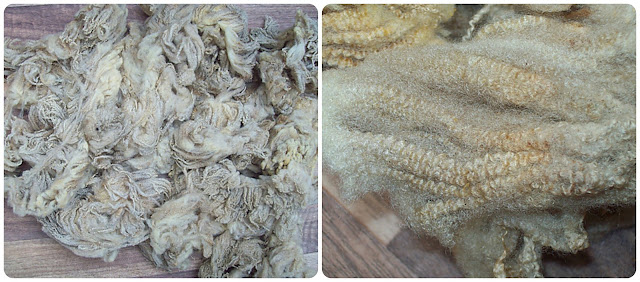Through one of the fleece/spinning forums that I am part of, a very nice farmer has been welcomed to our "flock" so that he can sell his award winning fleece direct to hand-spinners. He keeps and shows a beautiful flock of Cotswold Sheep. These are one of the Longwool breeds and he shows his sheep and then after the fleece have been sheared, he shows those too then at the end of the show season he sells the fleece to hand-spinners. I put my name down for one and it has arrived. WOW, its beautiful!!!
This is Angelo, the ram lamb that the fleece has come from and a photo of the fleece that Rob sent to me before I purchased it. Angelo's grandfather won the title of Champion Ram at the Royal Show.
Rob looks after his sheep extremely well and spends hours picking out all the VM from his fleeces so that they are in pristine condition for showing. This fact, and the fact that his fleece are out-of-this-world, make his fleece highly desirable and there is currently a waiting list, which at the time of writing is about 2 or 3 years long, meaning that is the length of time you have to wait to get your chance of getting your hands on one of these.
The starting weight of this fleece is 1950g but as you can see, its not white and its full of gorgeous lanolin which is great for the sheep, the fleece and my hands but not so great for my hand combs. Nice long staple and lots of lustre. Can't wait to see the wonderful yarn that this will make.
There was a small amount of second cuts and rubbish weighing 96g, a very small amount given the size of the fleece and a pile of locks waiting to be washed looks fantastic.
Washing
I used my usual method of washing a fleece which is separating the locks from the whole fleece and using net laundry bags to soak the locks in hot soapy water, regular dishwashing detergent is fine. I usually use one that also has anti-bacterial qualities too. My fleece has 2 hot soapy soaks to remove dirt and grease, followed by 2 plain hot water soaks to remove any residue soap and also to remove any further dirt trapped in the locks. Important: always run the hot water first, then add the soap and carefully/gently swirl the water. Do not shake your hands in the water, you do not want a bubble bath. Carefully lower the bag of fleece into the water and push down slowly and gently into the water. That is it, leave it alone for about 20 minutes, do not touch it or you will end up with a bag of felted mess. The hot water and soap will do its job perfectly well. When it comes to changing the water, you carefully lift one end of the bag over onto the other end (fold in half basically) and then lift the whole thing out and let the water run out before gently squeezing most of the excess water out, DO NOT WRING. Fill sink with fresh hot water and go again.



Just look at that water, and that is from the second hot soapy water soak.
Clean by comparison, or is it?
The locks on the left have been washed but the tips are still a bit mucky but these can be gently rubbed underneath the water and usually loosen up and shed their dirt. The locks on the right are in need of washing.
Lay out to dry, whoops, missed a bit of a dirty lock there, which was soon rectified.
Just ignore our mess in the background, my hanging drier is out in the utility room/storage area for some of the gardening bits and pieces and recyclable boxes etc. Look at how clean it looks close up now.


























































